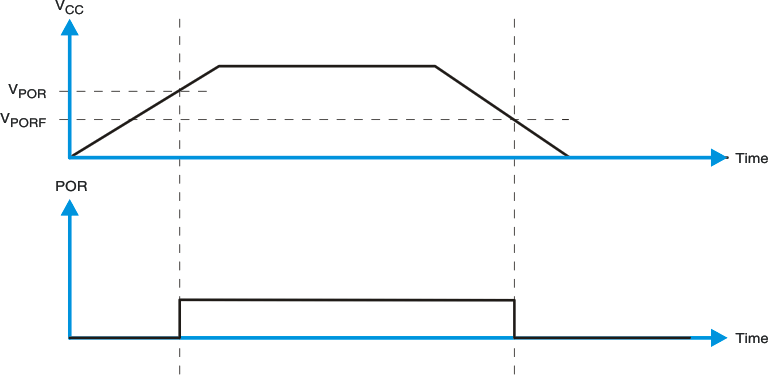ZHCS275D July 2010 – January 2023 TCA6424A
PRODUCTION DATA
- 1 特性
- 2 说明
- 3 Revision History
- 4 Description (continued)
- 5 Pin Configuration and Functions
- 6 Specifications
- 7 Parameter Measurement Information
- 8 Detailed Description
- 9 Application and Implementation
- 10Device and Documentation Support
9.2 Power Supply Recommendation
In the event of a glitch or data corruption, TCA6424A can be reset to its default conditions by using the power-on reset feature. Power-on reset requires that the device go through a power cycle to be completely reset. This reset also happens when the device is powered on for the first time in an application.
Ramping up the device VCCP before VCCI is recommended to prevent SDA from potentially being stuck LOW.
The two types of power-on reset are shown in #SCPS0691 and #SCPS0692.
 Figure 9-4 VCC is Lowered Below 0.2 V or 0 V and Then Ramped Up to VCC
Figure 9-4 VCC is Lowered Below 0.2 V or 0 V and Then Ramped Up to VCC Figure 9-5 VCC is Lowered Below the POR Threshold, Then Ramped Back Up to VCC
Figure 9-5 VCC is Lowered Below the POR Threshold, Then Ramped Back Up to VCCTable 9-1 specifies the performance of the power-on reset feature for TCA6424A for both types of power-on reset.
| PARAMETER | MIN | TYP | MAX | UNIT | ||
|---|---|---|---|---|---|---|
| tVCC_FT | Fall rate | See #SCPS0691 | 1 | 100 | ms | |
| tVCC_RT | Rise rate | See #SCPS0691 | 0.01 | 100 | ms | |
| tVCC_TRR_GND | Time to re-ramp (when VCC drops to GND) | See #SCPS0691 | 40 | μs | ||
| tVCC_TRR_POR50 | Time to re-ramp (when VCC drops to VPOR_MIN – 50 mV) | See #SCPS0692 | 40 | μs | ||
| VCC_GH | Level that VCCP can glitch down to, but not cause a functional disruption when VCCX_GW = 1 μs | See #SCPS0693 | 1.2 | V | ||
| tVCC_GW | Glitch width that will not cause a functional disruption when VCCX_GH = 0.5 × VCCx | See #SCPS0693 | 10 | μs | ||
| VPORF | Voltage trip point of POR on falling VCC | 0.767 | 1.144 | V | ||
| VPORR | Voltage trip point of POR on rising VCC | 1.033 | 1.428 | V | ||
Glitches in the power supply can also affect the power-on reset performance of this device. The glitch width (VCC_GW) and height (VCC_GH) are dependent on each other. The bypass capacitance, source impedance, and device impedance are factors that affect power-on reset performance. #SCPS0693 and Table 9-1 provide more information on how to measure these specifications.
 Figure 9-6 Glitch Width and Glitch Height
Figure 9-6 Glitch Width and Glitch HeightVPOR is critical to the power-on reset. VPOR is the voltage level at which the reset condition is released and all the registers and the I2C/SMBus state machine are initialized to the default states. The value of VPOR differs based on the VCC being lowered to or from 0. #SCPS0694 and Table 9-1 provide more details on this specification.
 Figure 9-7 VPOR
Figure 9-7 VPOR